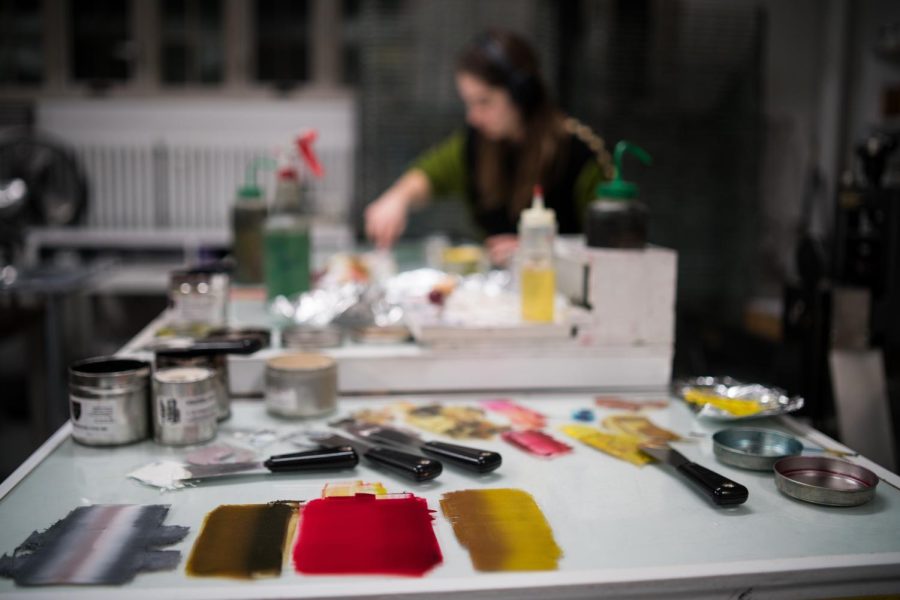Oberlin Students Should Utilize Reproducible Media Studios
Students are able to craft in Oberlin’s print lab and letterpress studio
Hidden behind the Allen Memorial Art Museum, and behind locked doors on the second floor of the Mary Church Terrell Main Library lie Oberlin’s print lab and the letterpress studio. The studio is filled with different methods of printing — for example, moveable type, a form of printing text that involves placing characters or letters on metal pieces. The courses offered in reproducible media studios are competitive: there are only a handful of spaces available, and they fill up quickly.
Associate Professor of Studio Art Kristina Paabus sees two sides of the printing world on campus: the side that involves working with students and teaching the techniques required to produce images, and the cogs and gears that make the print lab function.
“The Oberlin College Reproducible Media Print Lab is a curricular space, but also one of making, belonging, and community,” she said. “Students become authorized users of the lab through taking classes and in that process also become part of the shared atmosphere of creation, knowledge, and stewardship. Many print processes are complex with very steep learning curves, so the community aspect is one of the most magical elements of any print lab.”
Since 2014, Paabus has worked hard to expand the printmaking category of the Studio Arts department to include many different printing techniques, from screenprinting to lithography and digital forms of printing. She is very grateful to the college for investing in the reproducible media lab. Even with these new additions, there is always room for more machines and more space. Paabus noted that although print classes are relatively small by nature, as they require a lot of physical work, it is possible to access printmaking at Oberlin in other ways. Paabus hopes that the student body at large is aware of these opportunities.
“The print lab hosts various community events throughout the year, including live printing events during all of the end-of-semester Art Walk/Art Hop open studios,” Paabus said.
The letterpress studio is the other print studio at Oberlin, located on the second floor of Terrell Main Library. Although the letterpress studio does not offer classes the same way the print lab does, it is currently housing the Letterpress ExCo, co-taught by College third-year Elena Rabin. Rabin’s experience with printing at Oberlin solely consists of using the letterpress studio. She has printed everything from cards to books in the small space on the second floor of the library. The letterpress studio is currently run by Ed Vermue, a special collections and preservation librarian and member of the Book Studies committee.
“Ed Vermue works so hard to keep the letterpress studio accessible and organized,” Rabin said. “I’m thankful for him and for all of the amazing things we have access to because of him.”
Despite the fact that the letterpress studio is small, Vermue keeps it tidy and organized. There are many drawers of moveable type, every letter in almost any typeface you could dream of, as well as symbols ranging from decorative flourishes to trees and animals. The collection seems robust given the space, but Rabin still wishes there was more.
“I wish we had a larger space to work in, mostly,” Rabin said. “The Winter Term and ExCo are really the only ways into the letterpress studio, and both only accept eight to ten students. I wish the space itself could accommodate everyone who wanted to work in it.”
Rabin wishes the studio spaces were more accessible, but also recognizes that given the small space and cost of both tools and materials, it makes the most sense to keep the use of the space limited.
I was lucky enough to spend the spring semester of 2022 in the print lab. Through the course I took, I was able to dip my toes into this secret world that exists within Oberlin, but there are many people, both staff and students, who are far more familiar with reproducible media as a subculture and as a medium than I am. Take, for example, College fourth-year Chloe Casdagli, who is majoring in Studio Art and Creative Writing. They took their first print class in their second year, and they’ve been practicing printmaking since then.
“I find a lot of joy in making things by hand,” Casdagli said. “While I’ve grown fairly comfortable with Photoshop, photography, and other forms of digital art, I don’t get the same joy as I get with art I can actually touch. The physicality of printmaking is something I find rewarding and therapeutic, and differs from painting in its repetition and monotony. I love making work that I can reproduce easily and sell for much cheaper than a painting, but that also holds more personality than my digitally printed images.”
Casdagli, however, recognizes that many people cannot engage with the process in the same way that they’ve been able to and hopes to see more opportunities for a wider range of students.
“I definitely wish the print world here and in general was more accessible,” they said. “I understand why we can’t just open the doors to the print lab, but it’s a shame that taking Studio [Art] classes, which take a lot of time and money, are the only way to really get involved. I wish the art world was more accessible and less classist in general — considering printmaking’s history in protest, it’s sad to see it become another gatekept medium.”
The print resources at Oberlin may seem inaccessible or scary at times, and although that can definitely be true, there are many ways to access them. Through enrolling in courses or clubs, supporting print artists by buying their work, or by attending lab crawls or art walks, interested artists and art lovers can engage with the seemingly hidden printmaking community.










